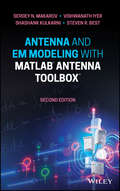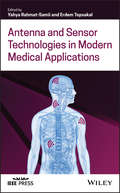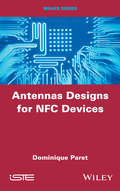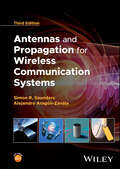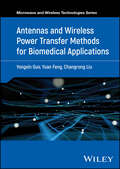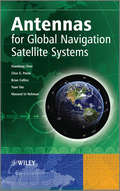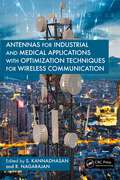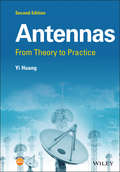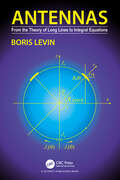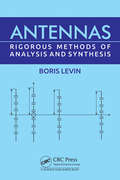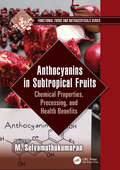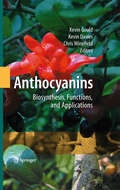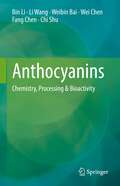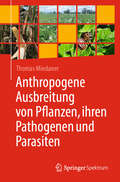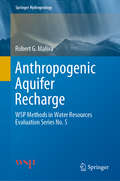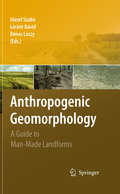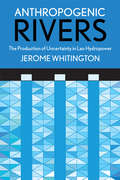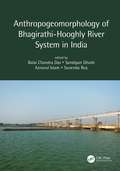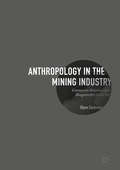- Table View
- List View
Antenna and EM Modeling with MATLAB Antenna Toolbox
by Sergey N. Makarov Vishwanath Iyer Shashank Kulkarni Steven R. BestAntenna and EM Modeling with MATLAB Antenna Toolbox™ is a textbook on antennas intended for a one semester course. The core philosophy is to introduce the key antenna concepts and follow them up with full-wave modeling and optimization in the MATLAB Antenna Toolbox. Such an approach will enable immediate testing of theoretical concepts by experimenting in software. It also provides the direct path to independent research work. The fundamental families of antennas – dipoles, loops, patches, and traveling wave antennas – are discussed in detail, together with the antenna arrays. Internally, the toolbox uses the Method of Moments (the method of integral equation) for modeling metal and metal-dielectric antennas. Rao-Wilton-Glisson basis functions on triangular facets are used for the metal parts and edge basis functions on tetrahedra are used for the dielectric parts. Accurate semi-analytical calculations of near-field interactions assure good solution accuracy.
Antenna and Sensor Technologies in Modern Medical Applications (Wiley - IEEE)
by Yahya Rahmat-Samii Erdem TopsakalA guide to the theory and recent development in the medical use of antenna technology Antenna and Sensor Technologies in Modern Medical Applications offers a comprehensive review of the theoretical background, design, and the latest developments in the application of antenna technology. Written by two experts in the field, the book presents the most recent research in the burgeoning field of wireless medical telemetry and sensing that covers both wearable and implantable antenna and sensor technologies. The authors review the integrated devices that include various types of sensors wired within a wearable garment that can be paired with external devices. The text covers important developments in sensor-integrated clothing that are synonymous with athletic apparel with built-in electronics. Information on implantable devices is also covered. The book explores technologies that utilize both inductive coupling and far field propagation. These include minimally invasive microwave ablation antennas, wireless targeted drug delivery, and much more. This important book: Covers recent developments in wireless medical telemetry Reviews the theory and design of in vitro/in vivo testing Explores emerging technologies in 2D and 3D printing of antenna/sensor fabrication Includes a chapter with an annotated list of the most comprehensive and important references in the field Written for students of engineering and antenna and sensor engineers, Antenna and Sensor Technologies in Modern Medical Applications is an essential guide to understanding human body interaction with antennas and sensors.
Antenna-in-Package Technology and Applications (Wiley - IEEE)
by Duixian Liu Yueping ZhangA comprehensive guide to antenna design, manufacturing processes, antenna integration, and packaging Antenna-in-Package Technology and Applications contains an introduction to the history of AiP technology. It explores antennas and packages, thermal analysis and design, as well as measurement setups and methods for AiP technology. The authors—well-known experts on the topic—explain why microstrip patch antennas are the most popular and describe the myriad constraints of packaging, such as electrical performance, thermo-mechanical reliability, compactness, manufacturability, and cost. The book includes information on how the choice of interconnects is governed by JEDEC for automatic assembly and describes low-temperature co-fired ceramic, high-density interconnects, fan-out wafer level packaging–based AiP, and 3D-printing-based AiP. The book includes a detailed discussion of the surface laminar circuit–based AiP designs for large-scale mm-wave phased arrays for 94-GHz imagers and 28-GHz 5G New Radios. Additionally, the book includes information on 3D AiP for sensor nodes, near-field wireless power transfer, and IoT applications. This important book: • Includes a brief history of antenna-in-package technology • Describes package structures widely used in AiP, such as ball grid array (BGA) and quad flat no-leads (QFN) • Explores the concepts, materials and processes, designs, and verifications with special consideration for excellent electrical, mechanical, and thermal performance Written for students in electrical engineering, professors, researchers, and RF engineers, Antenna-in-Package Technology and Applications offers a guide to material selection for antennas and packages, antenna design with manufacturing processes and packaging constraints, antenna integration, and packaging.
Antennas Designs for NFC Devices
by Dominique ParetNear-field communication (NFC) enables the exchange of information between close devices. The antenna is the indispensable element to transform an electronic device into an NFC system. For both theory and practice, this book presents in detail the design technologies of different antennas. They must meet the NFC ISO 18 092 and 21 481 standards as well as specifications by the NFC Forum for industrial applications, by EMVCo for banking applications and payments, and by CEN for public transport. In a particularly pedagogic way, Antenna Designs for NFC Devices enables designers of communicating object systems and the Internet of Things (IoT) to have access to the mysteries of the design of NFC antennas.
Antennas and Propagation for Wireless Communication Systems
by Simon R. Saunders Alejandro A. Aragón-ZavalaComprehensive resource describing both fundamentals and practical industry applications of antennas and radio propagation employed in modern wireless communication systems The newly revised and thoroughly updated Third Edition of this classic and popular text, Antennas and Propagation for Wireless Communication Systems addresses fundamentals and practical applications of antennas and radio propagation commonly used in modern wireless communication systems, from the basic electromagnetic principles to the characteristics of the technology employed in the most recent systems deployed, with an outlook of forthcoming developments in the field. Core topics include fundamental electromagnetic principles underlying propagation and antennas, basic concepts of antennas and their application to specific wireless systems, propagation measurement, modelling, and prediction for fixed links, macrocells, microcells, femtocells, picocells, megacells, and narrowband and wideband channel modelling with the effect of the channel on communication system performance. Worked examples and specific assignments for students are presented throughout the text (with a solutions manual available for course tutors), with a dedicated website containing online calculators and additional resources, plus details of simple measurements that students can perform with off-the-shelf equipment, such as their laptops and a Wi-Fi card. This Third Edition of Antennas and Propagation for Wireless Communication Systems has been thoroughly revised and updated, expanding on and adding brand new coverage of sample topics such as: Maxwell’s equations and EM theory, multiple reflections as propagation mechanisms, and waveguiding HAPS (High Altitude Platforms) propagation, design and noise considerations of earth stations, macrocell models, and cellular base station site engineeringFSS (frequency selective surfaces), adaptive antenna theory developments (massive and distributed MIMO in particular), and how to process raw data related to channel measurements for mobile radio systemsThe techniques used in mobile systems spanning the latest 4G, 5G and 6G technology generations A wider range of frequencies, extending from HF, VHF and UHF up to the latest millimetre wave and sub terahertz bands With comprehensive coverage of foundational subject matter as well as major recent advancements in the field, Antennas and Propagation for Wireless Communication Systems is an essential resource for undergraduate and postgraduate students, researchers, and industry engineers in related disciplines.
Antennas and Wireless Power Transfer Methods for Biomedical Applications (Microwave and Wireless Technologies Series)
by Yuan Feng Yongxin Guo Changrong LiuAntennas and Wireless Power Transfer Methods for Biomedical Applications Join the cutting edge of biomedical technology with this essential reference The role of wireless communications in biomedical technology is a significant one. Wireless and antenna-driven communication between telemetry components now forms the basis of cardiac pacemakers and defibrillators, cochlear implants, glucose readers, and more. As wireless technology continues to advance and miniaturization progresses, it’s more essential than ever that biomedical research and development incorporate the latest technology. Antennas and Wireless Power Transfer Methods for Biomedical Applications provides a comprehensive introduction to wireless technology and its incorporation into the biomedical field. Beginning with an introduction to recent developments in antenna and wireless technology, it analyzes the major wireless systems currently available and their biomedical applications, actual and potential. The result is an essential guide to technologies that have already improved patient outcomes and increased life expectancies worldwide. Readers will also find: Authored by internationally renowned researchers of wireless technologies Detailed analysis of CP implantable antennas, wearable antennas, near-field wireless power, and more Up to 100 figures that supplement the text Antennas and Wireless Power Transfer Methods for Biomedical Applications is a valuable introduction for biomedical researchers and biomedical engineers, as well as for research and development professionals in the medical device industry.
Antennas for Global Navigation Satellite Systems
by Brian Collins Xiaodong Chen Yuan Yao Clive G. Parini Masood Ur RehmanThis book addresses the fundamentals and practical implementations of antennas for Global Navigation Satellite Systems (GNSS)In this book, the authors discuss the various aspects of GNSS antennas, including fundamentals of GNSS, design approaches for the GNSS terminal and satellite antennas, performance enhancement techniques and effects of user's presence and surrounding environment on these antennas. In addition, the book will provide the reader with an insight into the most important aspects of the GNSS antenna technology and lay the foundations for future advancements. It also includes a number of real case studies describing the ways in which antenna design can be adapted to conform to the design constraints of practical user devices, and also the management of potential adverse interactions between the antenna and its platform.Key Features:Covers the fundamentals and practical implementations of antennas for Global Navigation Satellite Systems (GNSS)Describes technological advancements for GPS, Glonass, Galileo and CompassAims to address future issues such as multipath interference, in building operation, RF interference in mobileIncludes a number of real case studies to illustrate practical implementation of GNSSThis book will be an invaluable guide for antenna designers, system engineers, researchers for GNSS systems and postgraduate students (antennas, satellite communication technology). R&D engineers in mobile handset manufacturers, spectrum engineers will also find this book of interest.
Antennas for Industrial and Medical Applications with Optimization Techniques for Wireless Communication
by R. Nagarajan S. KannadhasanThe text begins by covering the fundamental concepts and new advances in the field of antenna theory, antenna hardware, and propagation. It further explains the designing of metamaterials microstrip patch antennas for medical applications, photonic crystals of millimeter wave signals for 5G communications, dual-band miniaturized circular antennas for wireless networks, and ultra-thin compact flexible antennas for wearable applications.This book: Presents the design and development of S-shaped and T-shaped microstrip path antennas for industrial applications. Highlights the use of W-shaped and metamaterials microstrip patch antennas for medical applications. Covers photonic crystals of millimeter wave signals for 5G communications. Showcases the importance of compact and wideband slot antenna for wireless communications. Illustrates the design of an ultra-thin compact flexible antenna for wearable applications. It is primarily written for senior undergraduates, graduate students, and academic researchers in the fields of electrical engineering, electronics and communications engineering, antenna design, and microwave engineering.
Antennas: From Theory to Practice
by Yi HuangAntennas From Theory to Practice Comprehensive coverage of the fundamentals and latest developments in antennas and antenna design In the newly revised Second Edition of Antennas: From Theory to Practice, renowned researcher, engineer, and author Professor Yi Huang delivers comprehensive and timely coverage of issues in modern antenna design and theory. Practical and accessible, the book is written for engineers, researchers, and students who work with radio frequency/microwave engineering, radar, and radio communications. The book details the basics of transmission lines, radiowaves and propagation, antenna theory, antenna analysis and design using industrial standard design software tools and the theory of characteristic modes, antenna measurement equipment, facilities, and techniques. It also covers the latest developments in special topics, like small and mobile antennas, wide- and multi-band antennas, automotive antennas, RFID, UWB, metamaterials, reconfigurable and MIMO antennas, and more. The new edition includes up to date information on a wide variety of newly relevant topics and trends, like adaptive impedance matching, the theory of characteristic modes, antenna materials and fabrication processes, and over-the-air (OTA) antenna system measurements. Many questions and examples are provided which enhances the learning experience. The book covers: An introduction to circuit concepts and transmission lines, including lumped and distributed element systems, transmission line theory, and the Smith Chart An exploration of field concepts and radiowaves, including wave equations and solutions and radiowave propagation mechanisms, characteristics, and models Discussions of antenna basics and popular antennas, including wire-type antennas, aperture-type antennas, and antenna arrays Information about antenna manufacturing and measurements, including antenna measurement facilities and methods The use of industrial standard simulation tools for antenna design and analysis Perfect for engineers and researchers who work in RF engineering or radar and radio communications, Antennas: From Theory to Practice, Second Edition will also earn a place on the bookshelves of university students seeking a concise and practical introduction to the basics of antennas and antenna design.
Antennas: From the Theory of Long Lines to Integral Equations
by Boris LevinThis book describes both known and new results. In the sections devoted to the use of integral equations for the current in a linear metal radiator, the focus is on Leontovich's equation. An advantage of this equation is the simplicity of the solution and the absence of the argument φ in it because the integration over φ already performed. The refined solution makes it possible to determine the total sum of the series for the current, which is close to the known solution including only the first terms. The results of the synthesis of different types of antennas with capacitive loads are presented, which makes it possible to implement Hallen's hypothesis about the usefulness of applying such loads to create an in-phase current distribution in antennas and to obtain required characteristics.New results include the widespread use of the complex potential method in relation to the calculation of capacitive structures in homogeneous and inhomogeneous media, antenna patterns and flows of electrical fields between antenna elements and in the surrounding space. In particular, the analysis of field flows makes it possible to substantiate a rigorous method for analyzing microstrip antennas. The characteristics of antennas in various conditions of their installation are considered and compared. The results of the use of multi-floors structures that provide in the wide frequency range the radiation in direction perpendicular to the antenna axis, and structures that make it possible to reduce the mutual influence of antennas located at different heights on a common mast are described.
Antennas: Rigorous Methods of Analysis and Synthesis
by Boris LevinThe book comprises a new method of solving the integral equation of Leontovich, the most rigorous and most effective equation for the current in thin linear antennas. The book describes the features of the new method in its application in various types of antennas. It considers new ways of analyzing antennas, in particular in the calculation of an antenna gain based on main radiation patterns and the calculation of the directional characteristics of radiators with known distribution of current amplitude. The method of electrostatic analogy proposed by the author, provides the base for comparison of electromagnetic fields of high-frequency currents and electrostatic charges located on linear conductors to improve the directional characteristics of log-periodic and director-type antennas. A new approach to the analysis of the electrical characteristics of a microstrip antenna, which allows expansion of its operation range, is substantiated and developed. New results of antenna synthesis are obtained. The second part of the book is devoted to specific types of antennas (the author had a significant role in their creation). Particular attention is given to ship antennas for different frequency ranges. The book is intended for professionals, working in electrodynamics and those working on development, placement and exploitation of antennas. It will be useful for lecturers (university-level professors), teachers, students of radio engineering and researchers working in various fields of radio electronics and interested in an in-depth study of theoretical problems and designs f antennas. It can also be used for short university courses.
Anthocyanins in Subtropical Fruits: Chemical Properties, Processing, and Health Benefits (Functional Foods and Nutraceuticals)
by M SelvamuthukumaranAnthocyanins are one of the powerful antioxidants that can alleviate several lifestyle diseases such as heart diseases and hypertension. They can reduce cancer by protecting cells against damage. Several subtropical fruits, including berries, plums, black grapes, apricots, and peaches, among others, are a rich source of anthocyanin. Consumption of these fruits will prolong the longevity of consumers; this is ascribed to the curative effects of anthocyanins present in those fruits. Anthocyanins in Subtropical Fruits: Chemical Properties, Processing, and Health Benefits discusses novel techniques adopted for the extraction of anthocyanins from various subtropical fruits. In this book, experts in the field examine solutions for efficiently extracting anthocyanins from subtropical fruits with higher yield. Protocols for the commercial production of anthocyanins from various subtropical fruits with their applications are also discussed in detail. Additional features: • Addresses chemical properties, classification, and stability of anthocyanins during processing and storage • Discusses the benefits of using both thermal and non-thermal processing methods for extraction of anthocyanins from various subtropical fruits • Explains the applications of synthetic and natural anthocyanins in foods and their regulatory aspects Providing comprehensive information on extraction techniques as well as the chemical and health properties of anthocyanins from various subtropical fruits, this book is a valuable resource for academic students, research scholars, and food scientists. 9781032127958_
Anthocyanins: Biosynthesis, Functions, and Applications (Advances In Botanical Research Ser. #Volume 37)
by Kevin Gould Kevin M Davies Chris WinefieldIn recent years there has been an unprecedented expansion of knowledge about anthocyanins pigments. Indeed, the molecular genetic control of anthocyanins biosynthesis is now one of the best understood of all secondary metabolic pathways. There have also been substantial improvements in analytical technology that have led to the discovery of novel anthocyanin compounds. Armed with this knowledge and the tools for genetic engineering, plant breeders are now introducing vibrant new colors into horticultural crops. The food industry has also benefited from the resurgence of interest in anthocyanins. A greater understanding of the chemistry of these pigments has led to improved methods for stabilizing the color of anthocyanins extracts, so that they are more useful as food colorings. Methods for the bulk production of anthocyanins from cell cultures have been optimized for this purpose. Possible benefits to human health from the ingestion of anthocyanin-rich foods have also been a major feature of the recent scientific literature. Anthocyanins are remarkably potent antioxidants, and their ingestion has been postulated to stave off the effects of oxidative stress. These pigments, especially in conjunction with other flavonoids, have been associated with reductions in the incidence and severity of many other non-infectious diseases, including diabetes, cardiovascular disease and certain cancers. An industry is developing around anthocyanins as nutritional supplements. Finally, there has been significant progress in our understanding of the benefits of anthocyanins to plants themselves. Originally considered an extravagance without a purpose, anthocyanins are now implicated in multifarious vital functions. These include the attraction of pollinators and frugivores, aposematic defense from herbivores, and protection from environmental stressors such as strong light, UVB, drought, and free radical attacks. Anthocyanins are evidently highly versatile, and enormously useful to plants. This book covers all aspects of the biosynthesis and function of anthocyanins (and related compounds such as proanthocyanidins) in plants, and their applications in agriculture, food products, and human health. Featured areas include their relevance to: * Plant stress * Flower and fruit color * Human health * Wine quality and health attributes * Food colorants and ingredients * Cell culture production systems * The pastoral sector
Anthocyanins: Chemistry, Processing & Bioactivity
by Bin Li Fang Chen Wei Chen Li Wang Weibin Bai Chi ShuThis book summarizes the current knowledge of anthocyanins, provides systematic information for future exploration of anthocyanin applications. It focuses on several aspects regarding the studying progression in the field of anthocyanins. The first section of the book provides a brief introduction to the scope and progress on anthocyanins, which is followed by the second section that describes the natural sources, structure, extraction approaches, bioavailability, and current stabilizing approach of anthocyanins. Then in the third part, the book focuses on the industrial processing of anthocyanins in foods by discussing the impact of food processing on anthocyanin structure and composition as well as classical processing techniques on anthocyanin-containing foods, including high-pressure, encapsulation, microwave, and combined application of the above techniques. In the last section of the book, the authors explore the currently most popular application of anthocyanins in improving human health, such as the effect of anthocyanin on vision, metabolism, neural system, cardiovascular system, and cancers. The book will facilitate readers’ understanding of the progress of anthocyanin studies. And it will benefit researchers and graduate students in the fields of natural products, functional food, and nutrition, etc.
Anthropogene Ausbreitung von Pflanzen, ihren Pathogenen und Parasiten
by Thomas MiedanerNoch nie sind Menschen und Waren so weit und so häufig gereist wie heute. Trotzdem spielte die Wanderung in der gesamten Geschichte der Menschheit eine große Rolle. So brachten die Bandkeramiker nicht nur die wichtigen Kulturpflanzen Weizen, Gerste, Linsen, Erbsen, Lein aus der Levante und Anatolien nach Mitteleuropa, sondern auch die Getreideroste Mehltau, Kornkäfer und Hausmaus. Ein paar Jahrtausende später kamen aus dem Osten Hirse und Hanf, Roggen und Hafer und um die Zeitenwende brachten die Römer zahlreiche neue Kulturpflanzen und Vorratsschädlinge nach Deutschland und England. Kolumbus und seine Nachfolger importierten Mais, Tomaten, Kürbis, Bohnen aus Mexiko und Kartoffeln von den Anden nach Europa und die dazu gehörigen Schädlinge kamen früher oder später nach. Der Kolonialismus wirbelte vor allem tropische Pflanzen durcheinander und heute baut Südamerika Kaffee, der ursprünglich aus Äthiopien kam, für die ganze Welt an. Seit der modernen Globalisierung cruisen ständig riesige Containerschiffe und Flugzeuge um die ganze Welt und bringen Passagiere und Fracht, aber auch Pathogene und Parasiten in die entlegensten Winkel dieser Erde. Dieses Buch zeigt die Auswirkungen weltweiter Migration von Pflanzen und die Krankheitsprobleme, die damit verbunden sind. Durch DNS-Untersuchungen können wir heute eindeutig die Herkunft von Schadpilzen und Schädlingen feststellen und erstmals ihre globale Dynamik verstehen. Gerade merken wir, dass Kulturpflanzen, Klimawandel und Krankheiten mehr miteinander zu tun haben als uns lieb ist und die Verbreitung von Krankheiten immer weiter geht. Dies bedroht auch unsere Ernten und lässt Lebensmittel teurer werden.
Anthropogenic Aquifer Recharge: WSP Methods in Water Resources Evaluation Series No. 5 (Springer Hydrogeology)
by Robert G. MalivaThe book is an overview of the diversity of anthropogenic aquifer recharge (AAR) techniques that use aquifers to store and treat water. It focusses on the processes and the hydrogeological and geochemical factors that affect their performance. This book is written from an applied perspective with a focus of taking advantage of global historical experiences, both positive and negative, as a guide to future implementation. Most AAR techniques are now mature technologies in that they have been employed for some time, their scientific background is well understood, and their initial operational challenges and associated solutions have been identified. However, opportunities exist for improved implementation and some recently employed and potential future innovations are presented. AAR which includes managed aquifer recharge (MAR) is a very important area of water resources management and there is no recent books that specifically and comprehensively addresses the subject.
Anthropogenic Environmental Hazards: Compensation and Mitigation
by Sadia Ilyas Pankaj Pathak Rajiv Ranjan SrivastavaThis book delves into the anthropogenic activities responsible for environmental hazards, their compensation, and potential mitigation strategies. It sheds light on the major contributors to the climate change issues aggravated by non-sustainable practices for the overexploitation of natural resources. Critical topics such as high emissions in primary mining, the recovery of energy-critical metals by urban mining, solid waste management, and forest conservation are explored, offering insights into the urgent challenges we face.Amidst the rapid demand for resources and the expansion of human habitats, the book emphasizes the need for new approaches to natural resource management and introspection of our actions. Experts in the field discuss existing anthropogenic environmental hazards in detail, alongside environmental compensation, and effective mitigation approaches.The book begins with a chapter dedicated to risk assessment in primary mining activities for precious metals, proposing potential routes for mitigation. Chapter 2 focuses on assessing and mitigating the environmental footprints of energy-critical metals used in permanent magnets. In Chapter 3, a case study examines sustainable resource utilization through end-of-life room air conditioner recycling. Additional chapters provide critical insights into:The environmental impacts of e-waste and government policies for responsible managementHazards associated with industrial effluents and corresponding mitigation strategiesThe role of roadside plants in phytoremediation of heavy metal pollutionSustainable utilization of anthropogenic coal fly ash through mechanical and chemical activationEnvironmental damages resulting from the mismanagement of municipal solid wasteEnvironmental problems and remediation strategies for anthropogenic biomass wasteChallenges in sustainable municipal solid waste management and suggestions for environmental risk mitigation The book concludes with a chapter discussing collaborative governance and non-monetary compensation mechanisms for sustainable forest management. Given its breadth, this book serves as an indispensable resource for researchers, policymakers, and environmental professionals seeking sustainable approaches to tackle pressing environmental challenges.
Anthropogenic Geomorphology: A Guide to Man-Made Landforms
by Denes Loczy József Szabó Lóránt DávidAnthropogenic geomorphology studies society's impact on the geographical environment, and especially on the Earth's surface. This volume provides guidance to students discussing the basic topics of anthropogenic geomorphology. The chapters cover both its system, and its connections with other sciences, as well as the way the subject can contribute to tackling today's practical problems. The book represents all fields of geomorphology, giving an introduction to the diversity of the discipline through examples taken from a range of contexts and periods, and focusing on examples from Europe. It is no accident that anthropogenic geomorphology has been gaining ground within geomorphology itself. Its results advance not only the theoretical development of the science but can be applied directly to social and economic issues. Worldwide, anthropogenic geomorphology is an integral and expanding part of earth sciences curricula in higher education, making this a timely and relevant text.
Anthropogenic Rivers: The Production of Uncertainty in Lao Hydropower (Expertise: Cultures and Technologies of Knowledge)
by Jerome WhitingtonIn the 2000s, Laos was treated as a model country for the efficacy of privatized, "sustainable" hydropower projects as viable options for World Bank-led development. By viewing hydropower as a process that creates ecologically uncertain environments, Jerome Whitington reveals how new forms of managerial care have emerged in the context of a privatized dam project successfully targeted by transnational activists. Based on ethnographic work inside the hydropower company, as well as with Laotians affected by the dam, he investigates how managers, technicians and consultants grapple with unfamiliar environmental obligations through new infrastructural configurations, locally-inscribed ethical practices, and forms of flexible experimentation informed by American management theory.Far from the authoritative expertise that characterized classical modernist hydropower, sustainable development in Laos has been characterized by a shift from the risk politics of the 1990s to an ontological politics in which the institutional conditions of infrastructure investment are pervasively undermined by sophisticated ‘hactivism.’ Whitington demonstrates how late industrial environments are infused with uncertainty inherent in the anthropogenic ecologies themselves. Whereas ‘anthropogenic’ usually describes human-induced environmental change, it can also show how new capacities for being human are generated when people live in ecologies shot through with uncertainty. Implementing what Foucault called a "historical ontology of ourselves," Anthropogenic Rivers formulates a new materialist critique of the dirty ecologies of late industrialism by pinpointing the opportunistic, ambitious and speculative ontology of capitalist natures.
Anthropogenic Soils (Progress in Soil Science)
by Jeffrey HowardThis book is a state-of-the-art review of the physical, chemical and mineralogical properties of anthropogenic soils, their genesis morphology and classification, geocultural setting, and strategies for reclamation, revitalization, use and management.
Anthropogenic Tropical Forests: Human–Nature Interfaces on the Plantation Frontier (Advances in Asian Human-Environmental Research)
by Noboru Ishikawa Ryoji SodaThe studies in this volume provide an ethnography of a plantation frontier in central Sarawak, Malaysian Borneo. Drawing on the expertise of both natural scientists and social scientists, the key focus is the process of commodification of nature that has turned the local landscape into anthropogenic tropical forests. Analysing the transformation of the space of mixed landscapes and multiethnic communities—driven by trade in forest products, logging and the cultivation of oil palm—the contributors explore the changing nature of the environment, multispecies interactions, and the metabolism between capitalism and nature. The project involved the collaboration of researchers specialising in anthropology, geography, Southeast Asian history, global history, area studies, political ecology, environmental economics, plant ecology, animal ecology, forest ecology, hydrology, ichthyology, geomorphology and life-cycle assessment.Collectively, the transdisciplinary research addresses a number of vital questions. How are material cycles and food webs altered as a result of large-scale land-use change? How have new commodity chains emerged while older ones have disappeared? What changes are associated with such shifts? What are the relationships among these three elements—commodity chains, material cycles and food webs? Attempts to answer these questions led the team to go beyond the dichotomy of society and nature as well as human and non-human. Rather, the research highlights complex relational entanglements of the two worlds, abruptly and forcibly connected by human-induced changes in an emergent and compelling resource frontier in maritime Southeast Asia.
Anthropogeomorphology of Bhagirathi-Hooghly River System in India
by Balai Chandra DasThe Bhagirathi-Hooghly Basin in India is one of the most densely populated regions in the world and is undergoing rapid transformation of its natural landscape induced by human interventions, such as mushrooming of dams and barrages, deforestation, and urbanization. Human activities and interventions on basin landforms and the processes that shape those landforms have accelerated at an alarming rate. This book uses spatio-temporal analysis to understand the major anthropogenic signatures on land use and land cover changes and the impact these activities have on the landforms and processes of the Bhagirathi-Hooghly River and its sub-basins. It answers the what, where, why, and how of the anthropogenic signatures involved. Recent case studies on the impact of anthropogenic signatures on fluvial forms and processes make this book a useful resource for students and researchers in the earth sciences, local governments, urban planners, and all concerned with rural developments. Features: Explores for the first time the new concept of anthropogeomorphology for the river basin—an emerging field Analyses the impact of anthropogenic activities, especially the construction of dams and reservoirs, and urbanization on major fluvial landscapes using advanced geospatial modelling techniques Investigates human interference in river systems, their effects on the dynamics of the river, and the livelihoods of the people residing along the river Addresses issues related to geology, geomorphology, geography, planning, land use, and land management areas Fills the need for data-driven governance and policy decisions for the future of urban-industrial growth in India.
Anthropology in the Mining Industry: Community Relations after Bougainville's Civil War
by Glynn CochraneThis book outlines how Rio Tinto--one of the world's largest miners--redesigned and rebuilt relationships with communities after the rejection of the company during Bougainville's Civil War. Glynn Cochrane recalls how he and colleagues utilized their training as social anthropologists to help the company to earn an industry leadership reputation and competitive business advantage by establishing the case for long-term, on the ground, smoke-in-the-eyes interaction with people in local communities around the world, despite the appeal of maximal efficiency techniques and quicker, easier answers. Instead of using ready-made, formulaic toolkits, Rio Tinto relied on community practitioners to try to accommodate local preferences and cultural differences. This volume provides a step-by-step account of how mining companies can use social anthropological and ethnographic insights to design ways of working with local communities, especially in times of upheaval.
Anthropometry: Human Body Measurements and How to Use Them (Body of Knowledge in Human Factors and Ergonomics)
by Waldemar Karwowski Beata MrugalskaToday, human factors and ergonomics professionals worldwide contribute to the design and evaluation of tasks, jobs, products, environments, and systems in order to make them compatible with the needs, abilities, and limitations of people. By understanding anthropometry, professionals can ensure that our home and working environments are comfortable and designed with the human in mind. This book aims to show how an understanding of anthropometrics can influence workspace design, ergonomics in the office, ergonomics in the home, and health and safety at work. This book discusses the measurement of the human body and human variability. Anthropometry may seem to be relatively simple but the reality is that it focuses on very sophisticated aspects of how to make the products tailor-made to suit specific requirements. As a study, it is useful for a variety of purposes such as workspace design, ergonomics in the office, ergonomics in the home, and health and safety at work. These eleven chapters investigate anthropometrics and bridge the gap between theory and practice. Each chapter is supported by tables, charts, and illustrations, and a wide list of bibliographic references. The reader will develop new insights into the principles and practice of anthropometrics with this book bringing the topic right up to date. Anthropometry: Human Body Measurements and How to Use Them will be of interest to students, graduates, teachers, researchers, and general workers in industrial design, ergonomics, rehabilitation, safety, and health.
Anti-Ageing Nutrients
by Deliminda NevesAgeing is a complex, time-related biological phenomenon that is genetically determined and environmentally modulated. According to even the most pessimistic projections, average lifespan is expected to increase around the world during the next 20 years, significantly raising the number of aged individuals. But increasing life expectancy presents new problems, and industrialized countries are facing a pronounced increase in lifestyle diseases which constitute barriers to healthy ageing. Anti-Ageing Nutrients: Evidence-based Prevention of Age-Associated Diseases is written by a multi-disciplinary group of researchers, all interested in the nutritional modulation of ageing mechanisms. Structured in three parts, Part 1 looks at the cellular modifications that underlie senescence of cells and ageing of the organisms; the effects of energy restriction on cellular and molecular mechanisms and in the whole organism; and the epigenetic modifications associated with ageing. Part 2 includes chapters which discuss the nutritional modulation of age-associated pathologies and the functional decline of organs, with a focus on those primarily affected by chronological ageing. Part 3 summarises the knowledge presented in the previous chapters and considers the best diet pattern for the aged individuals. The book reflects the most recent advances in anti-ageing nutrition and will be a valuable resource for professionals, educators and students in the health, nutritional and food sciences.
